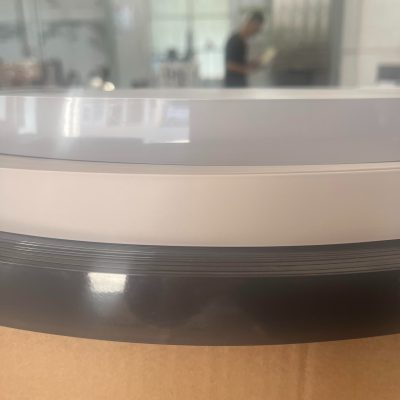Proper storage of edge banding is crucial to maintaining its quality and ensuring it remains in optimal condition for use in furniture and woodworking projects. Edge banding, typically made from materials like PVC, ABS, wood veneer, or melamine, can be sensitive to environmental factors such as temperature, humidity, and light. Here are some best practices for storing edge banding:
1. Store in a Cool, Dry Place
- Temperature Control: Edge banding should be stored in an environment where the temperature is stable, ideally between 60°F (15°C) and 77°F (25°C). Extreme temperatures can cause the material to become brittle or too soft, which can affect its performance during application.
- Humidity Control: Excessive humidity can cause wood veneer edge banding to warp or swell, while too little humidity can make it brittle. Aim to store edge banding in an area where the relative humidity is around 40-60%.
2. Keep Away from Direct Sunlight
- UV Protection: Direct sunlight can cause discoloration and degrade the material, especially for PVC and ABS edge banding. To avoid this, store edge banding in a dark or shaded area, or cover it with a UV-protective material if storage in a well-lit area is unavoidable.
3. Avoid Stacking Heavy Objects on Top
- Prevent Deformation: Edge banding can deform if heavy objects are stacked on top of it, especially if the material is stored in rolls. Store the rolls or strips in a way that prevents compression, such as on shelves or racks where they can be laid flat or hung.

4. Use Original Packaging
- Protection: If possible, keep edge banding in its original packaging until it’s ready to be used. The packaging is designed to protect the material from dust, moisture, and other environmental factors. If the original packaging is not available, consider wrapping the edge banding in protective plastic or other suitable materials.
5. Store Vertically for Long-Term Storage
- Avoid Creasing: For long-term storage, it’s advisable to store edge banding rolls vertically on a rack or stand. This method helps to prevent creasing or flattening of the roll, which can occur if stored horizontally for extended periods.
6. Label and Organize by Size and Material
- Easy Access: To streamline your workflow and prevent unnecessary handling, organize your edge banding by size, color, and material type. Label each roll or bundle clearly, so you can easily find what you need without having to unroll or move other materials.
7. Use a Climate-Controlled Environment if Necessary
- Special Considerations: If you’re dealing with particularly sensitive edge banding materials, such as exotic wood veneers or custom-finished products, storing them in a climate-controlled environment can help maintain their quality over time.
8. Rotate Stock
- First In, First Out: Practice the FIFO (First In, First Out) method, where older stock is used before newer stock. This ensures that no edge banding stays in storage for too long, reducing the risk of deterioration.
Conclusion
Proper storage of edge banding is essential to maintain its quality and usability. By controlling environmental conditions, keeping the material in its original packaging, and organizing it efficiently, you can ensure that your edge banding remains in excellent condition until it’s ready for use. Implementing these storage practices will help extend the life of your edge banding and ensure it performs optimally when applied to your woodworking projects.

